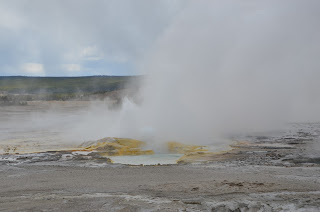We piled into the car for another day of adventuring, this time heading toward the ultimate destination of the Hayden Valley and the Lake Yellowstone Hotel. Along the way, there was plenty to be seen. Trumpeter swans glided along lakes of glass, and the earth transformed from an elk-filled wonderland to a mysterious, hazy land of steam. Plumes rose from the earth all around us for mile after mile. Today was a day to see Yellowstone’s many thermal features.
Our first stop was Roaring Mountain, an area where the steam rising from the earth was particularly concentrated. This area is a fumarole, otherwise known as a steam vent, which forcefully expels a small amount of heated water (as steam) along with other gases such as hydrogen sulfide and other sulfur gases. This water generally comes from melting snow, trickles into the fumarole’s underground plumbing system (a feature of all of these thermal features), and then exits under pressure through narrow vents (constriction points). This and other steamy features are best seen in the winter and on cold mornings, when the steam is most dramatic. Roaring Mountain now offers a gentle hiss, but it used to be much louder. During the 1800s, it could sometimes be heard four miles away at Obsidian Cliff. Over the years, changes to the plumbing system occur due to erosion by the water, deposits of silica, or – most dramatically – earthquakes. This can blow out the entire plumbing system, transforming a fumarole into a hot spring.
Next, we stopped at Beryl Spring, which is the hottest spring close to the road. Its temperature is just below boiling. Our guide, Brenda, told us that when the water is blue, the hot spring temperature is high, because it’s too hot for the thermophilic bacteria to grow. Beryl is a steamy one, bathing you in a faintly sulfuric mist. In the winter, the surrounding trees get a constant misting and are coated in ice crystals, creating “ghost trees”.We continued on, admiring Gibbons Falls, which has a heated watering hole that gets up to 80 degrees dur to the thermal springs and is open for swimming during the summer.
As we journeyed on, trailing the river, an osprey flew alongside the car, showing off its black wing underbars. When we reached open plains, we saw the other herd of Yellowstone bison, the central herd. Their grassy plains were already starting to dry out, revealing large patches of silica. This silica wears down the teeth of the grazing animals and can shorten their lifespan in areas where the silica content is highest.
Next up were some very pretty hot springs, including the famous Windows 7 screensaver: Grand Prismatic. This was one time that the cold weather worked against us, as the steam covered up some of the iridescence. The steam was so thick we had to take off our sunglasses and shuffle through areas of 2-foot visibility, waiting for the direction of the wind to change. People walking the other direction were writing out their hair from the wet, and the warm moisture turned freezing as soon as the hot mist dissipated. Several large pools lie in close proximity: Excelsior Geyser, Grand Prismatic, Opal Pool, and Turquoise Pool. Besides being beautiful, Grand Prismatic is Yellowstone’s largest hot spring, measuring 200 feet across. Its brilliant colors come from a combination of light scattering and thermophilic bacteria. Between the thermal features, a bacterial mat bears witness to the visiting wildlife, all of whom clear out before the two-legged tourists arrive each day. We spotted both wolf and bison tracks leading up to Grand Prismatic.
We managed to arrive 10 minutes before the eruption, then ducked into the Old Faithful Inn for lunch. This building looms six stories tall and is built from lodgepole pine trunks. A Crow’s Nest at the top rises 76.5 feet above the floor. During the early years of the Inn, they would host large parties where an orchestra would play from a room at the top of the Inn, spectators would watch from upper balconies, and guests wound dance on the lobby floor below. Unfortunately, the Crow’s Nest is now closed to visitors because the 1959 earthquake moved some of the structural supports.






























No comments:
Post a Comment